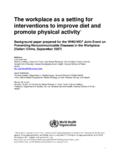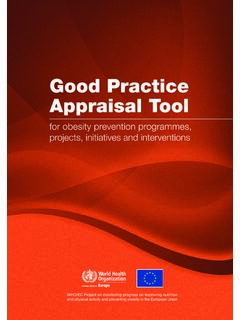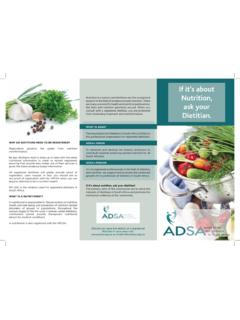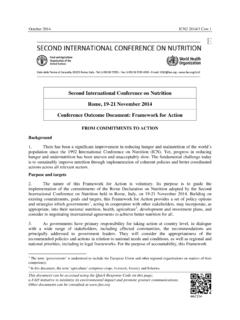Transcription of IMPROVING CHILD NUTRITION - UNICEF
1 IMPROVING CHILD NUTRITION . The achievable imperative for global progress United Nations Children's Fund ( UNICEF ). April 2013. Permission is required to reproduce any part of this publication. Permission will be freely granted to educational or non-profit organizations. Others will be requested to pay a small fee. For permission please contact: Division of Communication, UNICEF . Attention: Permissions, H-6F. 3 United Nations Plaza, New York, NY 10017 USA. Tel: +1 (212) 326-7434. Email: This report and any corrigenda subsequent to printing are available at ISBN: 978-92-806-4686-3. eISBN: 978-92-806-4689-4. United Nations Publications Sales No.
2 : Photo credits Cover: UNICEF /NYHQ2010-3063/Pirozzi Page 1: UNICEF /INDA2012-00208/Vishwanathan Page 2: UNICEF /NYHQ2010-3088/Pirozzi Page 3: UNICEF /NYHQ2010-3087/Pirozzi Page 7: UNICEF /NYHQ2009-0812/Ramoneda Page 17: UNICEF /NYHQ2011-0385/Asselin Page 28: UNICEF /Kyrgyzstan/2009/Gorshkova Page 33: UNICEF /NYHQ2012-1793/Sokol Page 34: UNICEF /NYHQ2008-1577/Pirozzi Page 39: UNICEF /NYHQ2012-0577/Ose Page 40: UNICEF /NYHQ2008-1373/Pietrasik Page 42: UNICEF /NYHQ2006-2243/Pirozzi Page 44: UNICEF /BANA2011-00682/Sujan Page 47: UNICEF /NYHQ1998-1166/Noorani Page 49: UNICEF /NYHQ2012-0178/Asselin Page 51: UNICEF /NYHQ2008-1390/Pietrasik Page 55: UNICEF /NYHQ2012-0353/Asselin Page 113: UNICEF /INDA2012-00201/Vishwanathan IMPROVING CHILD NUTRITION .
3 The achievable imperative for global progress CONTENTS. FOREWORD iii KEY MESSAGES iv CHAPTER 1: INTRODUCTION 1. CHAPTER 2: CAUSES AND CONSEQUENCES OF UNDERNUTRITION 3. CHAPTER 3: CURRENT STATUS OF NUTRITION 7. Stunting 8. Underweight 12. Wasting 13. Overweight 15. Low birthweight 16. CHAPTER 4: INTERVENTIONS TO ADDRESS STUNTING AND. OTHER FORMS OF UNDERNUTRITION 17. NUTRITION -specific interventions 17. Maternal NUTRITION 18. Infant and young CHILD feeding 19. Prevention and treatment of micronutrient deficiencies 23. Prevention and treatment of severe acute malnutrition 25. Water, sanitation and hygiene and access to health services 26.
4 NUTRITION -sensitive approaches 26. Maintaining the focus on equity 27. CHAPTER 5: IT CAN BE DONE: SUCCESS STORIES IN SCALING UP NUTRITION 28. Ethiopia: Reducing undernutrition with national planning 28. Haiti: Expanding NUTRITION services in an emergency 30. India: IMPROVING NUTRITION governance to reduce CHILD stunting in Maharashtra 31. Nepal: Making steady progress for women and children 32. Peru: Reaching the most disadvantaged by concentrating on equity 35. Rwanda: Reducing stunting through consolidated nationwide action 37. Democratic Republic of the Congo: Scaling up community-based management of severe acute malnutrition 38.
5 Sri Lanka: Reducing under-five mortality by expanding breastfeeding 40. Kyrgyzstan: Reducing iron deficiency with home fortification of food 41. United Republic of Tanzania: Institutionalizing vitamin A supplementation 43. Viet Nam: Protecting breastfeeding through legislation 45. CHAPTER 6: NEW DEVELOPMENTS IN GLOBAL PARTNERSHIPS 47. CHAPTER 7: THE WAY FORWARD 49. REFERENCES 52. NUTRITION PROFILES: 24 COUNTRIES WITH THE LARGEST BURDEN AND HIGHEST. PREVALENCE OF STUNTING 55. Infant and young CHILD feeding indicators and area graphs 104. Definitions of indicators 106. Data sources 111. STATISTICAL TABLES 113.
6 Table 1: Country ranking based on number of stunted children 114. Table 2: Demographic and nutritional status indicators 116. Table 3: Infant and young CHILD feeding practices and micronutrient indicators 120. Regional classification and general note on the data 124. ii IMPROVING CHILD NUTRITION FOREWORD. Poor NUTRITION in the first 1,000 days of children's lives More and more countries are scaling up their NUTRITION can have irreversible consequences. For millions of programmes to reach children during the critical period children, it means they are, forever, stunted. from pregnancy to the age of 2. These programmes are working.
7 Countries that are reaching mothers Smaller than their non-stunted peers, stunted children and children with effective NUTRITION and related are more susceptible to sickness. In school, they interventions during the first 1,000 days are achieving often fall behind in class. They enter adulthood more results. Stunting and other forms of undernutrition likely to become overweight and more prone to are decreasing. non-communicable disease. And when they start work, they often earn less than their non-stunted co-workers. But we must still reach millions of mothers and their children, especially those in the hardest to reach It is difficult to think of a greater injustice than robbing areas.
8 Urgently. a CHILD , in the womb and in infancy, of the ability to fully develop his or her talents throughout life. The World Health Assembly has set the goal of achieving a 40 per cent reduction in the number of This is a tragedy for the 165 million children under stunted children under 5 years old by 2025, or around the age of 5 afflicted by stunting in the world today. 70 million children saved from the misery of stunting. It is a violation of their rights. It is also a huge burden for nations whose future citizens will be neither as This report shows that we can attain that target. healthy nor as productive as they could have been.
9 Countries like Ethiopia, Haiti, Nepal, Peru and Rwanda are leading the way, quickly scaling up And let us not forget the tens of millions of children equity-focused initiatives. Committed to results, around the world who are vulnerable to the ravages they are achieving progress through advocacy, of life-threatening, severe acute malnutrition. Slowly, better allocation of resources and investments in treatment is expanding but, still, too many children tailored policies and programmes. remain out of its reach. About one third of under-five mortality is attributable to undernutrition. And where progress can be made, we have a moral obligation to do so.
10 At last, the gravity of undernutrition and its long-term effects are being acknowledged and acted upon with The legacy of the first 1,000 days of a CHILD 's life can increasing urgency. This is, in large part, in recognition last forever. So, we must do what we can, as fast as of the ever-growing body of compelling evidence we can, to give the most disadvantaged mothers and on the short- and long-term impacts of stunting children dependable, quality NUTRITION . and other forms of undernutrition. The right start in life is a healthy start and that Recognizing that investing in NUTRITION is a key way is the only start from which children can realize to advance global welfare, the G8 has put this high their promise and potential.

















